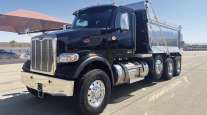Expect GHG Rules to Spark Another Pre-Buy Truck Splurge Before 2021, Experts Say

The Phase 2 rule, by two federal agencies, the Environmental Protection Agency and the National Highway Traffic Safety Administration, also could be complicated by California’s government, which wants to regulate nitrogen oxide emissions at the same time. Panelists at the ACT Research Co. seminar said March 30 that cutting carbon dioxide and nitrogen oxides simultaneously is a daunting engineering challenge.
EPA has said that during August it will publish the final version of Phase 2, which was described as having “the longest implementation period of any regulation ever imposed” on trucking, said Glen Kedzie, energy and environmental affairs counsel for American Trucking Associations.
In a separate presentation, ACT President Kenny Vieth forecast the rule will cut into North American truck production and sales.
Heavy-duty production should hit 327,000 vehicles in 2020 and fall to 199,000 in 2021, a decline of 39% in North America. Retail sales are expected to behave similarly, falling from 308,000 in 2020 to 248,000 in 2021, down 19.5%.
“There are potentially favorable conditions for pre-buying,” Vieth said in unveiling his firm’s forecast. “Low fuel prices would extend the fuel-efficiency payback period” envisioned by federal regulators, he added.
Vieth’s 2020 production estimate is slightly higher than the 323,000 Class 8s built last year. For this year, he predicts production will drop to 237,000 units.
Kedzie compared 2017 tractor-trailers, when Phase 1 is fully implemented, with big rigs to come during Phase 2, which will have pollution-control technology on diesel engines, tractors and 53-foot trailers. Using the proposed rule and its supplementary documents as a guideline, Kedzie said the cost additions would be about $8,700 in 2021 (Stage 1 for trucks of Phase 2), $12,300 in 2024 for Stage 2 and $14,250 per tractor-trailer in 2027, Stage 3, the final segment for the rule.
The California Air Resources Board could make life difficult by tightening NOx standards in 2024, or what is expected to be the middle stage of the Phase 2 rule.
Kedzie and Sean Waters, director of product compliance for Daimler Trucks North America, said CARB has stated it wants to lower the ceiling on NOx output to 0.02 gram per brake horsepower-hour from the current limit of 0.2 gram, a decrease of 90%.
The EPA-NHTSA proposal for Phase 2 that came out last year did not include changes in nitrogen oxide limits, but CARB has the right to act independently, said Kedzie, a former EPA attorney.
CARB also is much on the mind of Thermo King, the manufacturer of refrigerated units, said Todd Lutkauskas, the company’s strategic marketing manager.
The California agency is addressing trailer refrigerated units, or TRUs, from two angles, Lutkauskas said, limiting the time they can run on diesel when they could instead be plugged into an electrical outlet, and switching reefer fuel from diesel to hydrogen fuel cells.




